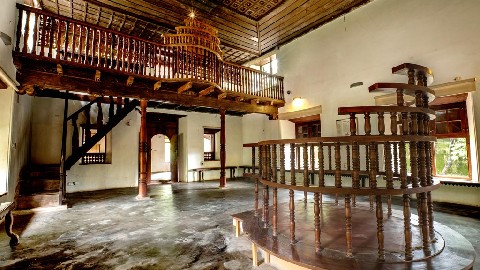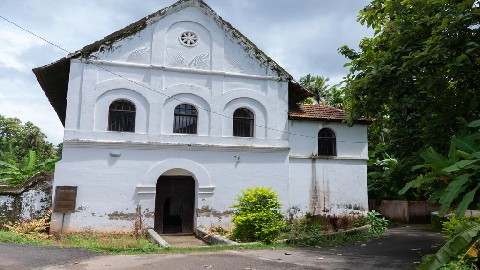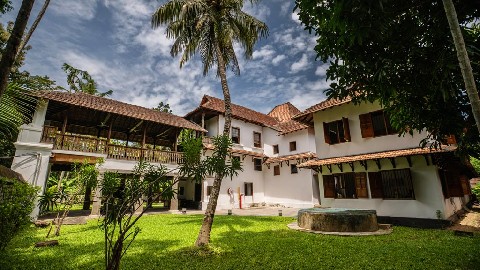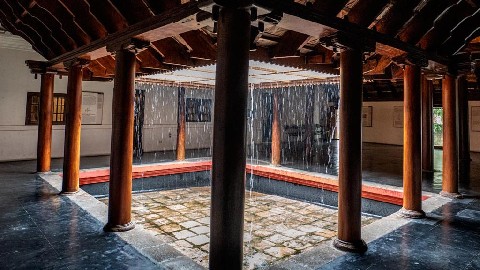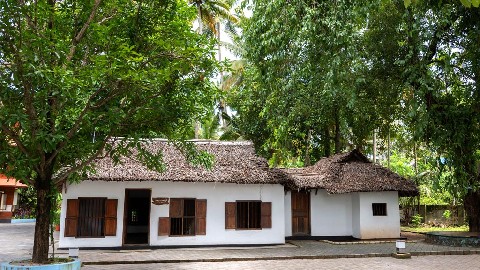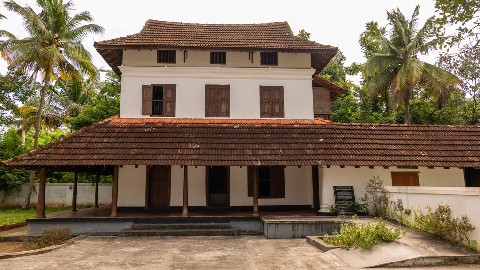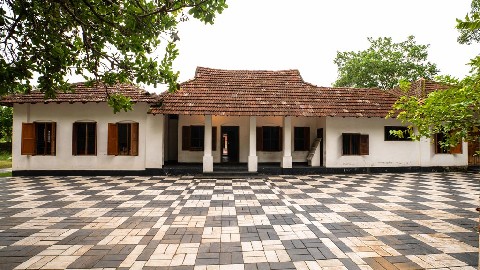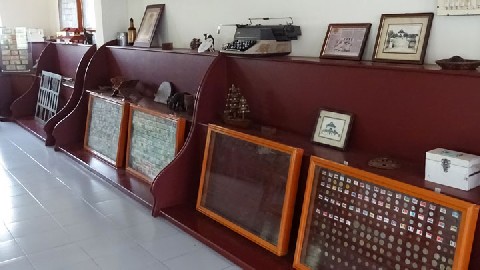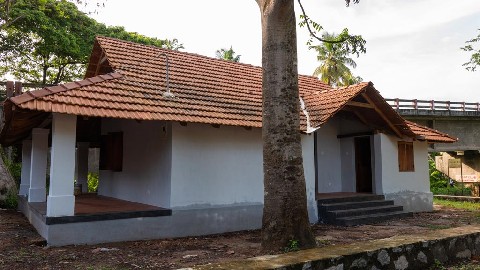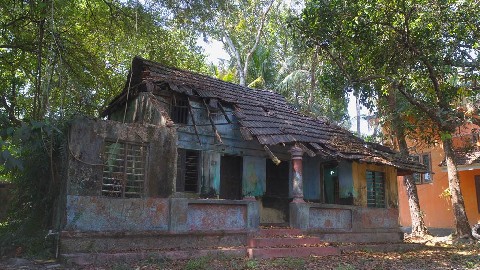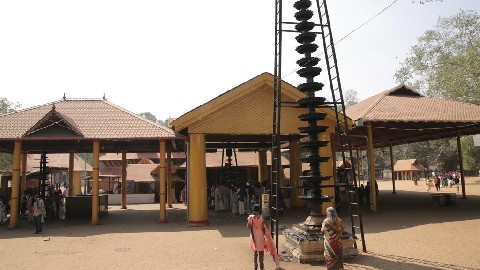Museums
Although seemingly quiet in its bearing, museums speak of eventful and momentous histories of the past. Some of the iconic monuments that trace the history of Muziris and the legendary figures that lived in this land are listed below.
Jewish Monuments in Kerala
Jews in Muziris
The Muziris Heritage Project gained a newer dimension with its acknowledgement of Jewish culture to the growth of our land, and its preservation of the physical remnants of their rich legacy. Historically, they are considered the oldest Jewish diaspora in India. The first Jews to reach Kerala were traders who came during the time of King Solomon, more than 2,000 years back. As trade relations grew, the Jews could not help noticing the ambience of tolerance in the land.
.jpg)
So it became their haven when they fled from the terrible atmosphere of religious persecution in their own homeland. They landed first at Muziris with their families and founded a settlement. Gradually, the Jews developed into a prosperous business community, with the warm welcome and generous patronage extended by the native rulers. It was not long before they began to enjoy a high and influential position in society. The Jewish community became a force to be reckoned with in the social, economic and political life of Kerala. However, they could hold sway only till the arrival of the Portuguese. When the newcomers persecuted them the Jews were compelled them to leave Kodungallur for Cochin in 1565.
Some of the most tangible and poignant reminders of Jewish settlement in Muziris are to be found in the synagogues where they offered worship and the cemeteries where they reverentially left their dead relatives. The Muziris Heritage Project has left no stone unturned to preserve these relics in order to show the future generations a glimpse of a culture that was once a vibrant power in this land.
The Synagogues
The life of the Jews and their history have an important place in the Muziris Heritage Project. The Jews settled long back in Paravur and Kodungallur regions of Kerala, and the two synagogues, one each at Paravur and Chendamangalam, still exist as a testimony to their glorious past. The Jews who lived in the Muziris Heritage Site area had ardently followed their religious practices, an important part of their worship being reading the Torah aloud in the synagogue.
The Ark of the Covenant
The Jewish Bible called Tanakh contains 24 books. It was written by different authors, and compiled for the first time in the 10th century. The first five books make up the Torah. This collection of books comprising a series of 613 commandments, which are basically God’s instructions to the people of Israel, forms the core of their belief.
The Torah scrolls are kept in the Ark of the Covenant – sacred, ornate, gold-plated wooden chest where the ancient Hebrews kept the two tablets containing the Ten Commandments. The Ark of the Covenant inside the synagogues of the Muziris region was built using wood. In all synagogues, it is a cabinet that sits behind a curtain in the synagogue wall that faces Jerusalem. The Ark of the Covenant is beautifully decorated with engravings and artworks, which are mainly influenced by the artworks of Spain and Italy. The decorated wooden boxes in which the Torah is kept is taken out during religious ceremonies. According to Jewish practices, the Torah is like a decorated bride. There are handles to support the Torah scrolls as it is considered sacred to touch. The holy book of Torah reveals God’s teaching about Himself, His purposes and how His words could help His people in every aspect of life.
Rabbi – The Teacher of the Torah
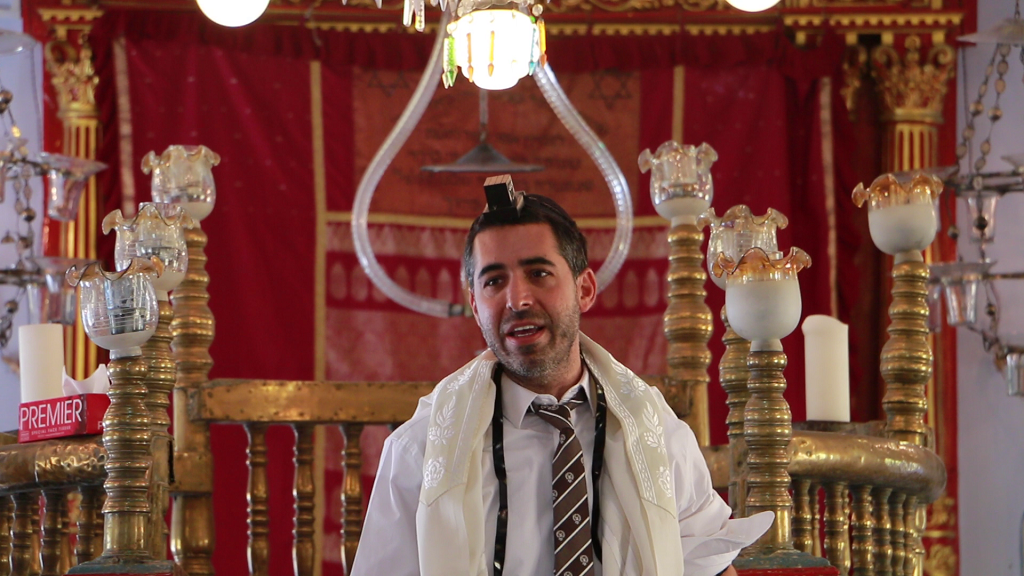
Imparting of spiritual knowledge and transcription of scrolls of the Torah were done by the rabbis. Rabbis were originally teachers, and they devoted themselves to studying the Torah. Spiritual study centres are known as Rabbanim. Such a centre above the gatehouse of Paravur synagogue was a Kerala model of Rabbanim. A collection of writings containing teachings, commentaries on the Hebrew Bible and learned debates is called the Talmud.
Holy Days and Festivals
The Jews who lived in the Muziris region kept their customs and practices alive, and celebrated their festivals with much ardour.
Pesach
Pesach [Passover] festival is one of the main festivals where the primary observance is related to the Exodus from Egypt after 400 years of slavery, as told in the biblical Book of Exodus from chapters 1 to 15. On the festival day of Pesach, the Jews eat only non-fermented food. Men and women work together and prepare the Pesach Appam/ cake.
On Sabbath day (set apart for religious observance and abstinence from work), Jews religiously gather together in the synagogue and read a portion of the Torah. This day is popularly known as ‘Chukkunda Perunnal’ and the 50th perunnal [festival] since this is the 50th day after Pesach.
The Jew calendar begins in autumn with Rosh Hashanah, the Jewish New Year festival. Special morning prayers are offered, thirty days prior to this day, and the Jews never sleep on the day of the festival. Ten days later is the Day of Atonement or Yom Kippur. This is the most solemn event in the Jewish calendar when the Jews spend the whole day praying, fasting and seeking God’s forgiveness.
The Jews in the Muziris region believed that the departed souls wandered around on the day of Yom Kippur. ‘Purium’ Perunnal was another festival celebrated for the remembrance of Princess Esther.
Hanukkah
Hanukkah, also known as the Festival of Lights, is an eight-day long midwinter festival that is marked by the lighting of candles. It celebrates the rededication of the temple of Jerusalem after it was recaptured from the enemies in 164 BCE. Like several other festivals in the Jewish religious year, Hanukkah reminds Jews of God’s love to His people.
During the festival, Jews in the Muziris region used to decorate their houses, streets and synagogues with lights, and also set fire to effigies made of hay and grass. They also danced, sang and distributed sweets during this time. On the first day of Hanukkah festival, Jewish women participated in Kaikottikali, an indigenous form of group dance.
Customs and Traditions
The Sabbath
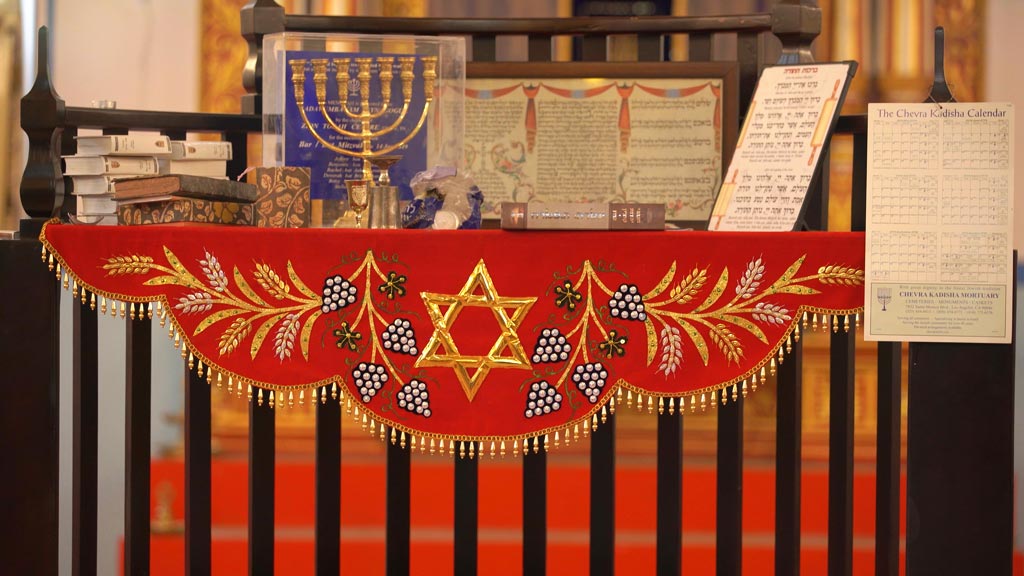
The Jews in the Muziris region of Kerala lived a religiously active life. Sabbath – stretching from Friday evening to Saturday evening – is the weekly day of religious observance and abstinence from work. It is a way of commemorating the way God rested after the creation. The Jews calculate their day from sunset to sunset. On the Sabbath, they dress themselves up in their best clothes, refrain from cooking, work or the use of transport. They offer prayers, study and rest on Sabbath days.
The path in front of the Paravur Synagogue was closed on the Sabbath days. Food on Sabbath day was prepared and eaten after observing religious rites.
The Significance of Lights
Lights are important in the life of Jews in the Muziris. It has a symbolic value that is deeply connected to their rigorous religious practices. Different kinds of lights are used in the Jewish synagogue and houses for religious purposes.
As part of the beginning of Sabbath rites, Jews used to light a wick on a stone font placed in front of their houses.
It was customary for the Jewish women to recite prayers after lighting Chattom vilakku to begin a Sabbath day. Glass lamps became popular among the Jews of the Muziris region after their contact with western culture. Later when electricity came into vogue, the customary rite of lighting the lamp became rare. People also started using candles. Menorah is a nine-branched candlestick used by the Jews in the Muziris area.
Nercha (Votive Offerings)
The word nercha in Malayalam means an offering to God. People belonging to all religious groups in Kerala consider nercha as an important religious activity. So did the Jews who lived in the same geographic region. Nercha was offered on Nehemiah Motha’s Remembrance Day as well. Nehemiah Motha was a Jewish mystic and poet who migrated to Cochin from Yemen. Motha died in 1916 and his grave is considered to be a centre of religious activities.
Manara and Theva
As the Jews in the Muziris region who immigrated to Kerala became an integral part of the state, they adopted many Malayalam words into their language, altering them slightly in the process. Manara is adapted from Manavara in Malayalam, and it is a decorated room for the newly wedded couple. As part of the Jewish festival – Simchat Torah – the Torah box is decorated and is named ‘Manara’. The concept comes from the idea that symbolically the Torah is a beautiful bride.
Silk shawls, with symbols of lions on them, are also used for decoration. The crown in the decoration symbolizes the Torah as the crowning glory of Jewish life. There are some properties used for religious requirements in the synagogues of Muziris. Theva or Theba was used in Jewish synagogues as a pedestal for placing the Holy Book during the time of the spiritual recitation. Another name of Theva is Bema. In the synagogues of the Muziris region, a Theva was placed in the balcony.
Food on Sabbath Days
Except on Sabbath day, the Jews in the Muziris region used to sit on the floor to have food. Food preparations of the Jews were mostly similar to Kerala food where vinegar and tamarind were used in abundance.
On Sabbath days, Appam or cakes prepared with wheat was an important food item. Wine was also prepared on special days. They did not cook on Sabbath days instead they kept certain food items on the hearth. A preparation with a mix of rice, coconut, onion and meat kept on a hot hearth was a special Sabbath food. Kubba was prepared by putting steamed meat inside rice flour. Pasthel was prepared with fried refined wheat filled with meat. Baked stone cake, black gram cake, etc. were also special Sabbath snacks.
Kosher Food of the Jews
The food of the Jews is religiously significant and is known as kosher food which conforms to certain regulations. Special certificates are issued by the religious authorities where the kosher food is sold.
Pesaha appam or cakes were jointly made by all the members of the Jewish family. A cake named Massa was prepared without fermentation and it was carefully done following certain religious practices. Grape wine was prepared locally, kept in jars and used as Pesaha wine. Animals that do not have cloven hooves or chew the cud are forbidden, as are the birds of prey and sea creatures without fins and scales. The animals that the Jews eat must have been slaughtered according to specific rules.
Jewish Women in Muziris
Jewish women in Muziris, were spiritually inclined and well versed in religious texts, spiritual literature and Jewish mythology. Jewish Penpaattukal – female songs – especially mention this. The discovery of Kola – about 50 notebooks containing Jewish songs from Kerala – are historically significant. The Torah was recited throughout 52 weeks, and concluded before the religious festival in the Malayalam month of Kanni [September-October].
‘Home’ and ‘family’ are given much importance in Jewish religion. There are various principles that dictate various aspects of daily life, from waking up in the morning and ritually washing the hands till the time of going back to bed, when benedictions are said, etc.
Jewish Songs
The Jews were a vibrant religious minority living in the Muziris region. They had a very rich collection of songs, especially those that spoke of their religious beliefs and experiences. The songs revealed the divinity of each Jewish community in its spiritual aspects. They also dealt with the relationship between different Jewish communities, their connection with the Kerala society, the importance of synagogues in a Jew’s life, etc.
The songs carried the tone of hymns as they were all songs of praise. Another interesting fact is that details about the construction of synagogues, the builder’s name and his family name were also included in the Jewish religious songs.
The Historical Aspect
The Jewish synagogues in the Muziris Heritage site in Paravur and Chendamangalam were once very lively places, adorned with colours and reverberating with cheerful sounds, as is very evident in their songs. Some Jewish songs also contained bits of important information related to the history of Kerala.
The Paravur synagogue was once attacked by the Portuguese and this is depicted in the Paravur song. Similarly, the Mala song speaks about the history of the Mala synagogue. The synagogue was constructed as per the commands of the King of Kodungallur, who wished to have people from all communities living in harmony, under his reign.
Women’s Songs
The Jews who lived in the Muziris region could very easily assimilate themselves with the life and culture of Kerala. They learned Malayalam, adopted cultural signs of Kerala and also, very interestingly, wrote and sang Malayalam songs. Special songs meant for or by Jewish women known as Penpaattukal candidly reveal details about the dress, ornaments and also character of Jewish women.
Jewish women’s songs mention two different sections of the Jewish community in the Mattancherry region of Kerala. Jewish women used to loudly recite the songs in the synagogues of Kerala when in many parts of the world, loud female voices inside the synagogues were tolerated. Vidyarambham – the initiation into the world of letters – is a sacred ceremony that has been in existence in Kerala society since time immemorial. The Jewish community adopted this holy ceremony, customizing it to suit their beliefs, and this practice is very beautifully depicted in their songs.
Wedding Songs
Although the Jews in the Muziris region adopted certain cultural aspects of Kerala, they still cherished their own customs and beliefs and these are revealed in their songs. An important element of Jewish songs is their wedding songs. A collection of these songs was published in 2005 under the title Kaarkushali, compiled by Dr Scaria Zacharia.
There are Thaali (mangalsutra) songs, which make it evident that the Kerala concept of thaali was adopted among Jews in their weddings. While the bride and groom entered the synagogue, the Hebrew songs in Shingli tune were sung.
Prayers held in Jewish synagogues of Kerala were also unique. The songs were sung in Hebrew and the tune set for the prayer was Shingli which was based purely in the Kerala style of music.
Jews as Religious Singers
Researchers and writers who have studied Jewish life in Cochin suggest that apart from the many religious texts and prayers the Jews used, their communities also produced many religious singers. They created their own unique songs, prayers, and composed hundreds of Hebrew songs to be sung on festive occasions. Mostly these were sung during the service in the synagogue, at the end of their prayers or in their houses. The writings of the community, known as Kollas, were collected from the Cochin Jews and published under the title Book of Songs and Praises. This book was used by members of the Ernakulam, Chendamangalam and Mala communities.
Peculiarities of Jewish Songs
The songs of the Jews contain descriptions of memories of the past, events in the present and hopes about the future. Noteworthy among them are the two Kili or parrot songs, both of which have the same event as their plot. The first parrot song tells the story of the Jews who lived in Kodungallur, where ‘they sat like birds in a row in a golden forest’. The second song narrates the story of their persecution, migration and their final settlement in their new home, the coast of Paravur in Kerala.
Much of Kerala’s culture and landscape have found expression in their songs. The songs indicate that the Jews lost their families on the way as they went searching for a new settlement in a foreign land.
The Jewish Cemetery
The synagogues in the Muziris region of Kerala had cemeteries associated with them.
.jpg)
According to Jewish belief, the graves should be protected, as the dead rest in the cemetery till the resurrection day. Therefore the Jews decorated the coffins with silk spreads. Their concern over the departed souls are described in the Jewish songs as well.
The Paravur Synagogue
The Jewish communities who reached the shores of Kerala at different periods of time and settled in and around the Kodungallur town were mainly involved in trade. Synagogues were their places of worship. Adopting numerous aspects of Kerala culture, the communities built the synagogues, after gaining special rights and privileges from the kings. Over the years, these synagogues were fated to endure repeated attacks by the Portuguese, the Dutch and the rulers of Mysore, all of which inflicted irrevocable damage on the structures. When Israel came into being, many of the Jews left Kerala in groups. The synagogues were left unattended and eventually the worship stopped.
One of the oldest synagogues is the Paravur synagogue. The Paravur Jewish Synagogue Museum, located on the erstwhile Jewish street in Paravur, is one among the largest surviving synagogues in Kerala. It was built in 1615 and served as the place of worship for the Jewish community that settled very close to the Paravur market.
The Paravur synagogue is the most expansive and complete among the synagogues in Kerala. The building consists of a porch with two rooms, a spacious front yard, long corridors, huge doors and stairs made of wood, whitewashed walls built using laterite blocks, and a wooden chamber adorned with intricate carvings.
Though worshippers have long since stopped visiting, it is now maintained as a museum as part of the Muziris Heritage Project. The Jew street still goes by that name.
Architectural Features
(1).jpg)
The structure of the Paravur synagogue is a brilliant confluence of Jewish and Kerala traditions. One of the most notable features is the direction of the ‘path’ that comes in from the outer lane and extends to the Padippura (a frontal structure at the entrance, in distinctly Kerala style) and further on through the frontal aisle, right up to the Bema, a raised platform from which the Torah was read. The influence of Kerala style is evident in the special seats designed for women on the second floor, and the hanging lamps that decorate the prayer room. The shape of the fan on the front wall of the prayer hall comes straight out of Portugal. The original ark, which was taken to Israel when the last of the Jews left the place, has been replicated as part of the restoration.
Exhibits
The Paravur Jewish Synagogue Museum speaks about the history of the Jews in Kerala, their arrival, settlements, modes of worship, occupation, the deterioration of the community and their present status.
.jpg)
There are detailed signboards, flat-screen TVs with short documentaries giving an account of the Jews in Kerala and also certified guides to walk you through the historic sites. The synagogue helps the visitor understand the nuances of Jewish life, the social hierarchies and, most importantly, the native cultural influences on the immigrant Jewish community, which are evident in the style of architecture they patronized. It is located about 100 meters from Paravur-Kodungallur Road on NH-17.
The Chendamangalam Synagogue
The Jewish communities who reached the shores of Kerala at different periods of time and settled in and around the Kodungallur town were mainly involved in trade. Synagogues were their places of worship. Adopting numerous aspects of Kerala culture, the communities built the synagogues, after gaining special rights and privileges from the kings. Over the years, these synagogues were fated to endure repeated attacks by the Portuguese, the Dutch and the rulers of Mysore, all of which inflicted irrevocable damage on the structures. When Israel came into being, many of the Jews left Kerala in groups. The synagogues were left unattended and eventually the worship stopped.
The Jews who came from Kodungallur and Palayur to Chennoth (Chendamangalam) in 1420 built a synagogue for the Malabari [black] Jews. This synagogue built in the model of the Jerusalem Temple was destroyed in a fire, rebuilt in 1614, and renovated several times later. It is situated near the Kottayil Kovilakam hill, the headquarters of the Villarvattom Swaroopam, a local fiefdom in Cochin. It was the king of Villarvattom who offered land to the Jews to build the synagogue. As the Jews in Kerala returned to Israel during the 1960s, the worship at the synagogue came to a halt. In 1938, the Cochin wing of the Archaeological Department of Kerala renovated the structure and declared it a protected heritage site.
The Chendamangalam Synagogue, now maintained as a museum as part of the Muziris Heritage Project, showcases the lives and rituals of Kerala Jews who, even while remaining firm believers of their culture, lived in harmony with the local community. The front door opens to the Azara or the anteroom which leads to the vast prayer room. Behind it is the altar adorned with decorative works. A spiral staircase leads to a balcony and the prayer room which accommodates the second Bema (elevated platform for Torah reading). Two stone pillars with intricate carvings support it. The Ark made of teak, comprising beautifully carved images, is positioned on the wall across the door. The wooden planks on the roof have carved images of lotus that are painted.
Chendamangalam also bears significance as a centre of religious harmony and cultural coexistence, because a temple, a mosque, a church and a Jewish synagogue stand in close proximity to one another. Constructed during the 17th century on the land donated by the Paliam family, the Chendamangalam synagogue belonged to the black Jews and is arguably one of the oldest in Kerala. At the entrance is a fragment of a tombstone of a woman who died in 1264 AD. Other fragments of tomb engravings have also been found in the cemetery to the eastern side. This synagogue has been renovated and revived to its former glory by the Government of Kerala, and now houses a small museum that gives glimpses of early Jewish life in Kerala.
Architectural Features
(1).jpg)
The synagogue stands as a testament to India’s rich Jewish heritage, and points to an atmosphere of tolerance that prevailed here. The antechamber within the synagogue is called the Azara which leads to the ‘sanctuary’. The men assembled here to pray. The women gathered to pray in their own space upstairs, behind the wooden screen partition. In the centre of the sanctuary was the raised curved Tebah, where the Torah scrolls were unrolled and read. To the far end of the sanctuary was the Heichal, the focal feature of the room and where the Torah scrolls were kept. A beautiful set of colourful glass and metal lanterns originally hung from the lotus-patterned painted ceiling.
Though there are no Jews living here, the sanctity of the region is respected and kept intact. The most eloquent instance of it can be seen in the preservation of a Hebrew tombstone that stands in front of the Chendamangalam Jewish synagogue in Ernakulam district. The stone, carries an inscription dated 1269 CE, and the epigraph in Hebrew reads thus: ‘Here rests Sarah Bat Israel, who died and joined her creator on (day) (month) (year)’.
Exhibits
The Chendamangalam Synagogue museum showcases the Jewish customs in Kerala, the role of women in the Jewish community, Jewish songs, the peculiarities of their culture, etc.
.jpg)
Paliam Palace Museum
The Paliath Achans were Prime Ministers to the Kings of Cochin, and their residences were as palatial as to merit the name Kovilakam or palace. At one point of time, when trade wars among various foreign powers broke out, the then Paliath Achan offered substantial help to the Dutch, especially when they were threatened by the Portuguese. Later, the Dutch built a building in Chendamangalam, in appreciation of Paliath Achan’s services. The latter used it as his official residence where a number of major political and administrative decisions were made and put into action. The structure is also known as the Dutch Palace.
‘Achan’ is the title given to the karanavar (head of the family) of the Paliam noble family. During the 17th and 18th centuries, he held the posts of Prime Minister and Chief of Army of the Kingdom of Cochin. As loyal ministers, Paliyath Achans defended Cochin against various domestic and foreign threats. During those times, Cochin witnessed many battles over rights with the Portuguese, the Dutch and the English. Cochin also faced frequent attacks from the Zamorins of Kozhikode, the Mysore army and also received threats from Thiruvithamcode. The stages of evolution of Cochin kingdom, the importance of the Paliam family and the life of nobility in the ‘Post-Swaroopam’ period constitute the theme of this museum.
The Kovilakam was meant solely for the residence of Valiyachan of Paliam. The two buildings nearby were used as his offices. Achan held court in the Durbar Hall at the eastern end of the first floor where he received the subjects and officials of the kingdom, and listened to the problems of the people.
Architecture
.jpg)
The architectural style of Paliam Kovilakam reveals a confluence of Kerala and Dutch styles. The three-storeyed building can be considered as a highly efficient functional building of its times. In spite of minimum ornamentation, the building reflects the Dutch influence in its architecture. The structure features elaborately carved wooden staircases, balustrades and thick walls with splayed openings. A circulation space runs along the private area of the building, facilitating air movement and insulates the interior, making it cooler compared to the peripheral rooms. In earlier times, women were not allowed inside. Only the elder members of the family could stay there. The Paliath Achans used to address the people of Chendamangalam from the Prasanga Peedam [speech pedestal], at the entrance passage of the palace.
Exhibits
The Paliam Palace museum chronicles the historic records, letters of the Paliam family and important events that took place in the palace. There are panels which give brief descriptions in Malayalam and English about the exhibits in the museum. Interactive videos comprising short clips in Malayalam and English about rituals, rites, etc. and interactive audios which provide brief descriptions about historical aspects are also available. The museum also provides guidebooks in English and Malayalam, and the services of trained guides.
Paliam Nalukettu Museum
A central courtyard, that opens to the sky, and is surrounded on all four sides by a series of rooms – this was a typical quadrangular nalukettu structure that was patronized by the upper castes in Kerala in the past. The wealth of the owner decided the complexity of the structure (a single sprawling complex could have as many as four nalukettus) and the number of storeys. The Paliam Nalukettu in Chendamangalam was one such residential complex of one of the most powerful families in the erstwhile princely state of Cochin but its uniqueness lay in its aura of sheer majesty.
It was the traditional tharavad (homestead) where several generations of the matrilineal joint family of Paliam lived together. The nalukettu consists of a main house along with a few satellite houses. Portico, inner hall, kitchen and four blocks – Northern, Southern, Eastern and Western – constitute the different parts of a traditional nalukettu. The design and construction pattern are closely linked to the life cycle of women in the family, their rituals, beliefs and celebrations. The nalukettu was occupied by the women of the Paliam noble family who followed the matrilineal system. This structure is also an epitome of the traditional housing architecture of Kerala. The Paliam Nalukettu museum presents to the visitor, the architectural model of nalukettu and various social-cultural and economic practices from the feudal era.
This classical structure was built by the elder member of the family in the year 1786, for the women and minor boys of Paliam. It has a big courtyard at the centre surrounded by several rooms, and a purathalam [outer hall], where the family gathered to chat and to enjoy recreational activities. There used to be a common dining hall and a common kitchen as all the members lived and dined together, under the protection of Valiyachan. When the boys became majors, they had separate bachelor living quarters and after their weddings, the administration provided them houses. This style of 'community living' continued until the partition of the joint family. The last members left the nalukettu after the family partition deed and now the building is maintained as a heritage site under the Muziris Heritage Project.
The Matrilineal Legacy
Like the Cochin royal family, the Paliam family also followed the matrilineal system, where the lineage was traced through the mothers. The karanavar (head of the family) was called Valiyachan, and the inheritance rights went to his nephew (sister’s son). Valiyachan held the status of being the manager of the family. Unlike other nalukettus where the oldest male member of the family was in charge of household administration, in Paliam, the control of the nalukettu rested with Valiyamma.
Architectural Features
The nalukettu is a typical self-contained upper-caste Malayali house, a quadrangular building consisting of four blocks, with a rectangular courtyard in the centre known as the nadumuttam. The western block or padinjattini is divided into three rooms, the middle one of which is the private strong room or ara where all the valuables and household deities are kept. The northeast block or vadakkini is divided into two parts, the kitchen and the dining room. The other rooms in the northern quarter are general rooms. The whole or the middle portions of the eastern and southern blocks kizhakkini and thekkini are open halls where guests are received. The same on the upper floors consist of bedrooms for the women.
Exhibits
The main exhibits here include the hall, kitchen, vessels gallery and an exclusive collection of lamps. There are panels which give brief descriptions in Malayalam and English about the exhibits in the museum. Interactive videos comprising short clips in Malayalam and English about rituals, rites, etc. and interactive audios which provide brief descriptions about historical aspects are also available. The museum also provides guidebooks in English and Malayalam, and the services of trained guides.
Sahodaran Ayyappan Museum
On May 29, 1917, a humble abode situated in Cherai, Ernakulam district, became the site of a significant act of defiance against social discrimination and the cruel caste system that characterized the era. Ayyappan, a courageous young man from the Ezhava community, dared to challenge the entrenched practice of untouchability and advocated for misrabhojanam, a revolutionary act where individuals from different castes sat together to share a meal—an act considered blasphemous at that time.
Through his initiative called Sahodara prasthanam, meaning the "brotherhood movement," Ayyappan embarked on a mission to advance his cause, and soon gained recognition as "Sahodaran" Ayyappan (1889-1968). Today, that very house is renowned as the Sahodaran Ayyappan Museum, paying tribute to the memory of Sahodaran Ayyappan, a prominent social reformer, journalist, activist, and a devoted disciple of Sree Narayana Guru.
The museum offers visitors a captivating blend of interactive and traditional exhibitions, providing an authentic and immersive experience. The museum complex comprises traditional thatched-roof houses woven from coconut leaves, including the very house in which Sahodaran Ayyappan was born. Its location offers a scenic waterfront view of the Periyar river, adjacent to the Muziris Heritage Project boat jetty. Within its walls, the museum chronicles the life and achievements of Sahodaran Ayyappan, shedding light on the social movements he spearheaded to combat the prevalent caste discriminations that plagued Kerala society during that time.
Abdul Rahman Sahib Museum
Mohammed Abdul Rahman Sahib (1898-1945) was a freedom fighter, Muslim leader and scholar from Azhikode in Thrissur district. His contribution to the freedom struggle was significant in that he participated in the Salt Satyagraha in 1930. He was subjected to severe lathi charge, and put in Kannur Central Jail. He also worked towards peace and harmony when the land was torn by communal riots. His house, built in the traditional Kerala architectural style known as nalukettu, has now been converted into a museum.
The museum showcases the sacrifices made by and the achievements of Mohammed Abdul Rahman Sahib as a social reformer and a freedom fighter. The museum pays tribute to the leaders and the unsung heroes of our nationalist movement. There are video displays, information boards and documentaries installed in the museum multimedia system that provide detailed accounts of Abdul Rahman Sahib and his contribution to the freedom struggle.
Architecture
As a traditional homestead of ancient Kerala, this double-storeyed nalukettu building consists of a number of rooms, courtyard and an open verandah. There are three openings to the building, one positioned to the west, and rest to the east. The ground floor has four rooms around a central courtyard that opens to the sky. A staircase at the northern side of the central courtyard leads to the first floor that has two small rooms.
The museum is close to the Marthoma Church, Azhikode beach, the archaeological site of Cheramanparambu and the Kodungallur Bhagavathy Temple. The museum is situated at a distance of about 7 kms west of the Cheraman Juma Masjid, one of the first and world-renowned mosques in India.
Kesari Balakrishna Museum
Kesari Balakrishna Pillai (1889-1960) was a fearless journalist, influential thinker and visionary who spoke and worked relentlessly for establishing a single unified world without boundaries and barriers. His contribution to Malayalam literature was indirect but substantial and praiseworthy. He introduced works of world literature to his Malayali leadership and thus moulded many a native genius like Thakazhi Sivasankara Pillai, Pottekkatt, Vaikom Muhammed Basheer and others.
His erstwhile home, situated in North Paravur where he lived and worked from 1943 to 1960, is now a museum that showcases the writer’s contribution to the society.
Islamic History Museum Cheraman Juma Masjid
The Cheraman Juma Masjid in Kodungallur, believed to have been built in 628 AD by Malik Ibn Dinar during the lifetime of Prophet Muhammed, is considered to be the earliest masjid in India. It has undergone several renovations and restorations over the centuries and is now getting a facelift as part of the Muziris Heritage Project. It is located towards the left of the Ernakulam- Guruvayoor NH 17 road, and 2 kms south of Kodungallur.
According to an apocryphal oral tradition, Cheraman Perumal the Chera king, went to Arabia, met the Prophet and embraced Islam. From there he sent letters to his relatives in Kerala through Malik Ibn Dinar asking them to be courteous to the latter. Thus it is believed that this masjid was built by Malik Ibn Dinar. The original structure was modified with a lot of additions over the years which made the structure a mix of features from Kerala and Middle Eastern architectural styles. The addition of a new museum here makes it the state’s first Islamic heritage museum maintained as part of the Muziris Heritage Project. It has been set up in the Cheraman Juma Masjid complex.
The museum illustrates the history of Islam in Kerala and is presented to visitors through information panels and visual media. Murals and paintings of the story of Cheraman Perumal, the Chera king who embraced Islam, are elaborately displayed in the museum. The active role of Kodungallur in the freedom struggle of India and the history of Muslim rulers are also narrated through audio-visual presentations.
Bungalow Kadavu Museum
A building that hosted many English intellectuals and writers during the time of the British Raj, Bungalow Kadavu at Mathilakam has been taken over by the Muziris Heritage Project for conversion into a museum with the aim of conserving and promoting the history and heritage of the building. Renovations on the current structure have been completed. It will be converted into a museum in order to showcase the special features of the bungalow, through exhibitions and galleries.
The bungalow used to host officials of the East India Company and the Government of India, Collectors, Deputy Collectors and many such officials. The most prominent guests who stayed here include the eminent judge William Logan, author of The Malabar Manual, published in 1887, which is an authentic account of the Malabar district; Rhodes Morgan, the District Forest Officer of Malabar, who wrote the chapter on flora and fauna for the Manual; and Henry Conolly who was responsible for the development of the Conolly Canal.
The proposed museum adheres to two aspects – Conservation and Development. The Conservation largely focuses on the restoration of the architectural character of the building while the Development centres on the revival of the functional character of the building.
The galleries in the museum will give an overview of the British visitors, the bungalow, the contributions of Logan and the illustrations by Rhodes.
The above image is the outpost, part of Bungalow, used for collecting tax (Chungam).
P. Kesavadev Museum
P. Kesavadev (1904-1983) was a revolutionary, social reformer and activist who bravely fought the inequalities enforced by caste discrimination. His claim to immortality however lies in a different field altogether. Kesavadev is one of the celebrated writers in Malayalam literature, whose contributions to the genre of the novel is especially respected. Odayil Ninnu (1942) catapulted him to the acme of fame, and put him in the same league as the all-time greats of Malayalam literature, like Thakazhi Sivasankara Pillai and Vaikom Muhammed Basheer. His subsequent works only reinforced his stature as one of the progressive writers in the language.
His home at Kedamangalam in Paravur will be converted into a functional museum by the Muziris Heritage Project in order to conserve and protect the invaluable works of Kesavadev, and celebrate his unparalleled contributions to society.
Kodungallur Temple Museum
Sree Kurumba Bhagavathy temple is one of the most famous temples in Kerala. Goddess Kali the deity is believed to be in her fierce ugramoorthy form here. She is considered the eldest of all the Kalis venerated in the rest of the kavus [sacred groves] in the state, like in Madayi, Valapattanam, Lokanarkavu, Thiruvalayanadu kavu, Kodikkunnu, Thirumaandhamkunnu, Chettikkulangara and so on.
The temple will set up a museum to promote research on the state’s temple arts, rituals, murals and architecture. The plan is initiated by the Government of Kerala as part of the Muziris Heritage Project, in an effort to conserve the ancient monuments and traditions in Kerala. A building in the Devaswom land inside the temple complex is earmarked to be conserved as the temple museum.
